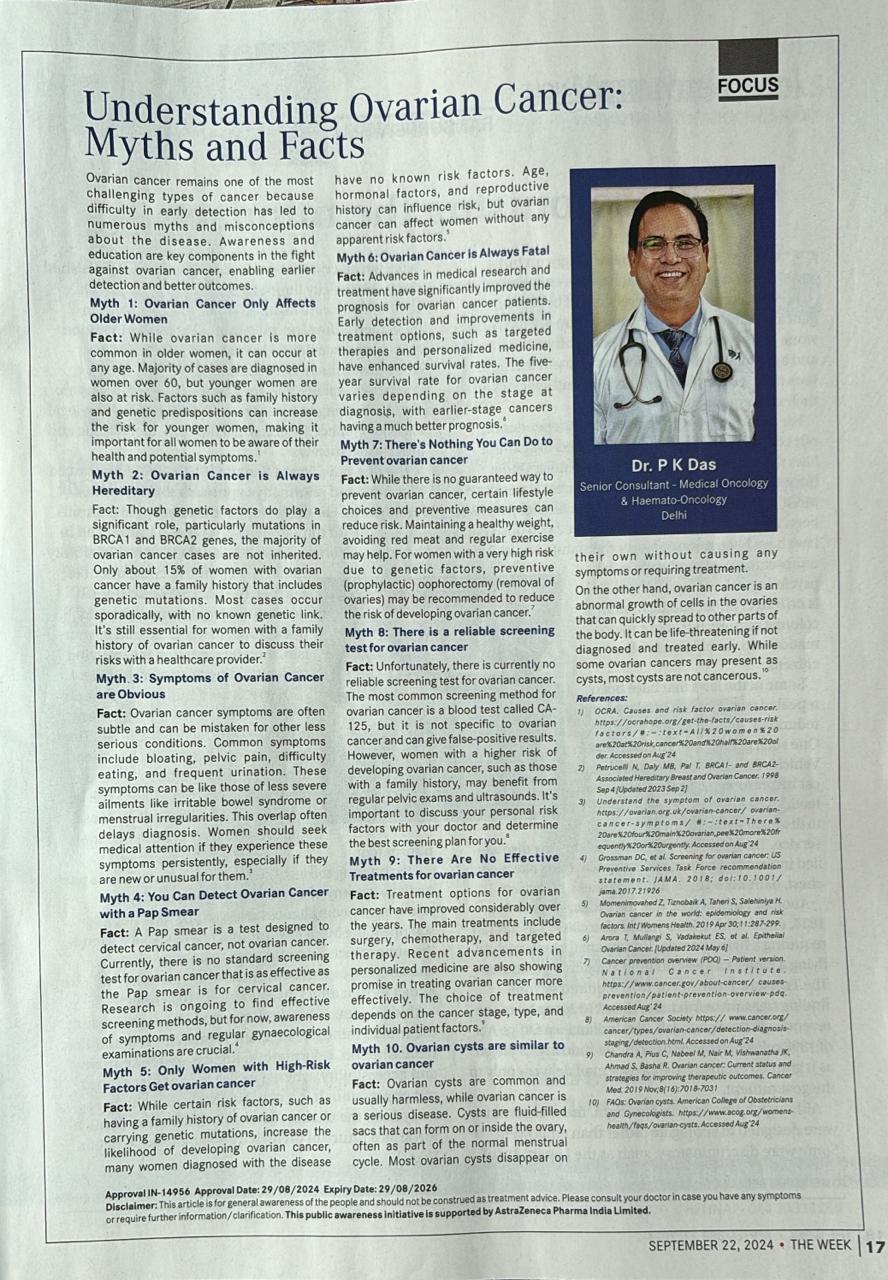|
Getting your Trinity Audio player ready...
|
Ovarian cancer remains one of the most challenging types of cancer because difficulty in early detection has led to numerous myths and misconceptions: about the disease. Awareness and education are key components in the fight against ovarian cancer, enabling earlier detection and better outcomes.

Myth 1: Ovarian Cancer Only Affects Older Women
Fact: While ovarian cancer is more common in older women, it can occur at any age. Majority of cases are diagnosed in women over 60, but younger women are also at risk. Factors such as family history and genetic predispositions can increase the risk for younger women, making it important for all women to be aware of their health and potential symptoms.”
Myth 2: Ovarian Cancer is Always Hereditary
Fact: Though genetic factors do play a significant role, particularly mutations in BRCA1 and BRCA2 genes, the majority of ovarian cancer cases are not inherited. Only about 15% of women with ovarian cancer have a family history that includes genetic mutations. Most cases occur sporadically, with no known genetic link. It’s still essential for women with a family history of ovarian cancer to discuss their risks with a healthcare provider.”
Myth. 3: Symptoms of Ovarian Cancer are Obvious
Fact: Ovarian cancer symptoms are often subtle and can be mistaken for other less serious conditions. Common symptoms include bloating, pelvic pain, difficulty eating, and frequent urination. These symptoms can be like those of less severe ailments like irritable bowel syndrome or menstrual irregularities. This overlap often delays diagnosis. Women should seek medical attention if they experience these symptoms persistently, especially if they are new or unusual for them.”
Myth 4: You Can Detect Ovarian Cancer with a Pap Smear
Fact: A Pap smear is a test designed to detect cervical cancer, not ovarian cancer. Currently, there is no standard screening test for ovarian cancer that is as effective as the Pap smear is for cervical cancer. Research is ongoing to find effective screening methods, but for now, awareness of symptoms and regular gynaecological examinations are crucial.”
Myth 5: Only Women with High-Risk Factors Get ovarian cancer
Fact: While certain risk factors, such as having a family history of ovarian cancer or carrying genetic mutations, increase the likelihood of developing ovarian cancer, many women diagnosed with the disease
have no known risk factors. Age, hormonal factors, and reproductive history can influence risk, but ovarian cancer can affect women without any apparent risk factors.”
Myth 6: Ovarian Cancer is Always Fatal
Fact: Advances in medical research and treatment have significantly improved the prognosis for ovarian cancer patients. Early detection and improvements in treatment options, such as targeted therapies and personalized medicine, have enhanced survival rates. The five- year survival rate for ovarian cancer varies depending on the stage at diagnosis, with earlier-stage cancers having a much better prognosis.”
Myth 7: There’s Nothing You Can Do to Prevent ovarian cancer
Fact: While there is no guaranteed way to prevent ovarian cancer, certain lifestyle choices and preventive measures can reduce risk. Maintaining a healthy weight, avoiding red meat and regular exercise may help. For women with a very high risk due to genetic factors, preventive (prophylactic) oophorectomy (removal of ovaries) may be recommended to reduce the risk of developing ovarian cancer.’
Myth 8: There is a reliable screening test for ovarian cancer
Fact: Unfortunately, there is currently no reliable screening test for ovarian cancer. The most common screening method for ovarian cancer is a blood test called CA- 125, but it is not specific to ovarian cancer and can give false-positive results. However, women with a higher risk of developing ovarian cancer, such as those with a family history, may benefit from regular pelvic exams and ultrasounds. It’s important to discuss your personal risk factors with your doctor and determine the best screening plan for you.”
Myth 9: There Are No Effective Treatments for ovarian cancer
Fact: Treatment options for ovarian cancer have improved considerably over the years. The main treatments include surgery, chemotherapy, and targeted therapy. Recent advancements in personalized medicine are also showing promise in treating ovarian cancer more effectively. The choice of treatment depends on the cancer stage, type, and individual patient factors.
Myth 10. Ovarian cysts are similar to ovarian cancer
Fact: Ovarian cysts are common and usually harmless, while ovarian cancer is a serious disease. Cysts are fluid-filled sacs that can form on or inside the ovary, often as part of the normal menstrual cycle. Most ovarian cysts disappear on their own without causing any symptoms or requiring treatment. On the other hand, ovarian cancer is an abnormal growth of cells in the ovaries that can quickly spread to other parts of the body. It can be life-threatening if not diagnosed and treated early. While some ovarian cancers may present as cysts, most cysts are not cancerous.

